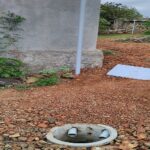- info@akanrajita.com
- Subhash Nagar (Near Govt. Tourist Bunglow), Varanasi
Rain Water Harvesting
What is rainwater harvesting (RWH)?
Rainwater harvesting is a technique of collection and storage of rainwater into natural reservoirs or tanks or the infiltration of surface water into subsurface aquifers (before it is lost as surface runoff). RWH is a simple, easy and cost effective technique of aggregating water and delivering it to water resources like borewells. RWH has the potential to overcome problems caused by drought and water scarcity.
Rainwater harvesting is a technique of collection and storage of rainwater into natural reservoirs or tanks or the infiltration of surface water into subsurface aquifers (before it is lost as surface runoff). RWH is a simple, easy and cost effective technique of aggregating water and delivering it to water resources like borewells. RWH has the potential to overcome problems caused by drought and water scarcity.

Water and Rain
As much as 97% of the world’s total water is in oceans, 2% is locked in the polar caps and only the balance 1% is fresh water. Of this 1%, India’s share is 4% whereas our population share is 18% of the world’s population[1].
As much as 85% of drinking water schemes in rural areas of Maharashtra depend on groundwater. Due to the drought-like conditions over the last few years, groundwater extraction rate has exceeded the recharge rate. Desperate farmers are using tankers to irrigate pomegranate orchards in Solapur. Rains help to maintain the ground water table through natural percolation, besides maintaining surface water levels. RWH is expected to play a major role in bringing depleted water levels up.
Potential of rainwater harvesting
The average annual rainfall in India is about 1120 mm. Within Maharashtra, the average rainfall is about 1300 mm but varies between 400 mm and 6000 mm across the state. Using the state average of 1300 mm, the average annual RWH potential per acre would roughly be 4.4 million litres [2].
The total amount of water received in the form of rainfall over an area is called the rainwater endowment of that area. Out of this, the amount that can be effectively harvested is called the water harvesting potential.
Promoting a RWH movement
According to central and state government resolutions, it is compulsory to have RWH systems on the buildings of local government bodies. But RWH systems are not functional or operational at many government offices. These systems are broken due to the use of poor quality material and ignorance of officials regarding the maintenance of RWH systems.
Some measures that can be taken to overcome the present water crisis include:
- Financial support for RWH: The material for installing RWH systems should be available at subsidized rates. MLAs, MPs and non-government organizations (NGOs) should fund RWH systems in their area. RWH projects should be initiated at public places like schools, health centres and gram panchayats.
- Citizen awareness campaigns educating the public about the potential & benefits of RWH systems to improve the falling water table.
- Strict implementation of RWH policies by local bodies.
- Training of local officials on RWH systems & testing before issuing NOCs to new buildings as well as old buildings.
- Mandating that borewells are to be dug only with permission from the local government and approved only if it is combined with an undertaking to recharge water levels using RWH systems.
- Planned replacement of old water pipes to reduce leakage in a phased manner.
- Policy-level progress on water conservation issues.
- Encouraging all homes to build a RWH system.




